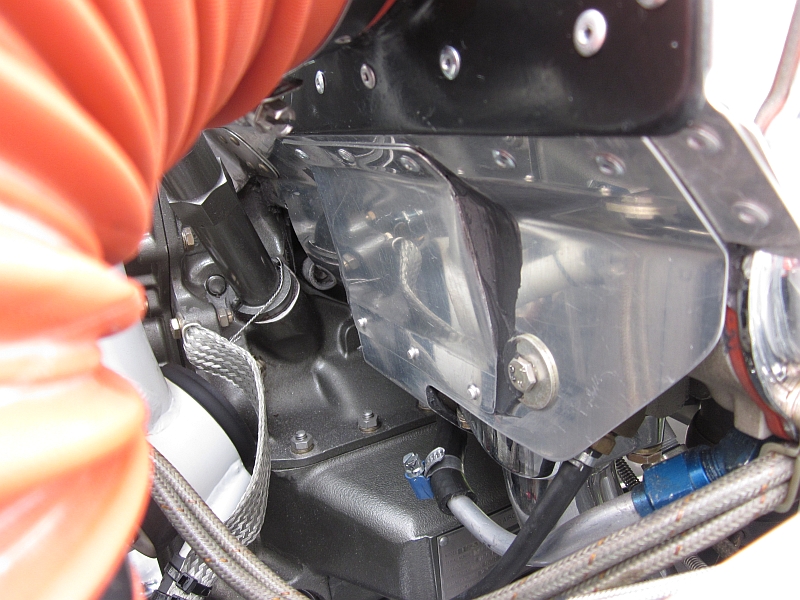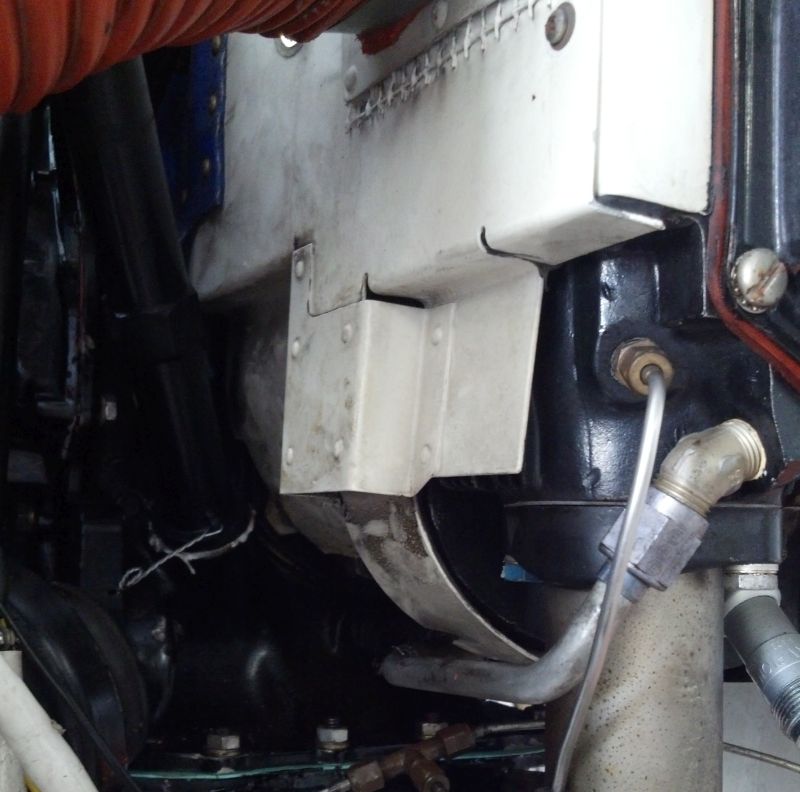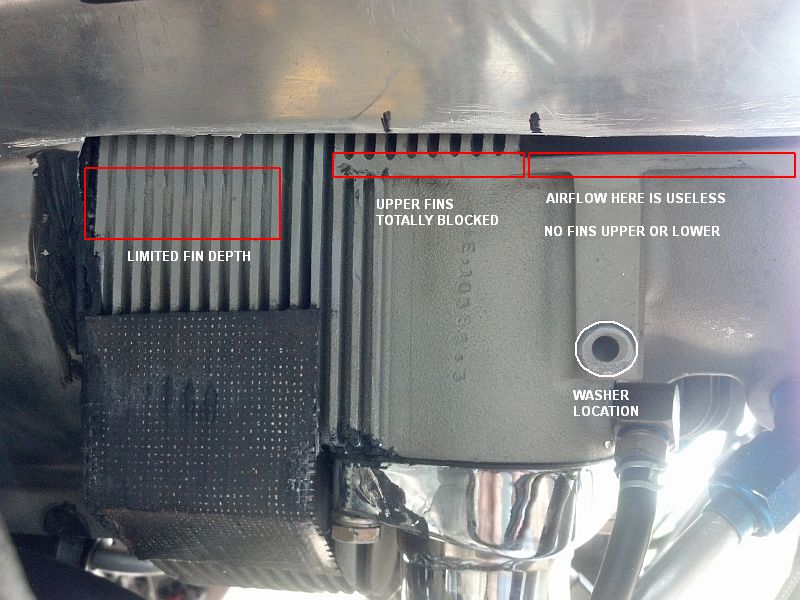RV9A, IO360. Catto Tri-prop. I am now 16 hours into my phase 1 flight on normal cruse seeing 385F CHT at 3,000' cyl. #1 the hottest running, OAT is 76F. On climbs at that altitude 500 FPM they can all push over 400F. what actions have some of you guys performed to bring these temps. down?? Thanks, Mark C. 119RV
Van's Air Force
You are using an out of date browser. It may not display this or other websites correctly.
You should upgrade or use an alternative browser.
You should upgrade or use an alternative browser.
Running Too HOT
- Thread starter Mark C.
- Start date
Do you have the standard Van's baffle kit with the air dam in front of cyl #1? If so, try cutting it down or removing it. Inlet air ramps installed? I had to remove and re-glass my inlet ramp forward on the right side. This provided more area above #1 and brought temps down about 10 degrees. Absolutely sure your baffles are sealed everywhere?
Also, is it a new engine? If so it will probably cool down a good bit as it breaks in. And lastly, do you have wheel pants and fairings installed? I just installed my main gear fairings and saw a gain of 5-7 knots and temps down another 8-10 degrees.
I am at a similar point in Phase 1 as you. My goal is under 400 all the time - right now #1 creeps over 400 in a climb (it's also 90 degrees OAT...). I'm getting close, and think that adding wheel pants and front gear fairing will do the trick.
Chris
Also, is it a new engine? If so it will probably cool down a good bit as it breaks in. And lastly, do you have wheel pants and fairings installed? I just installed my main gear fairings and saw a gain of 5-7 knots and temps down another 8-10 degrees.
I am at a similar point in Phase 1 as you. My goal is under 400 all the time - right now #1 creeps over 400 in a climb (it's also 90 degrees OAT...). I'm getting close, and think that adding wheel pants and front gear fairing will do the trick.
Chris
Last edited:
RV7AJeremy
Well Known Member
Get the wheel pants on. I saw 10-15 degree drop in CHT's once installed. I have an IO-360 with hartzel CS prop. Your numbers don't seem too far off from what I saw during initial break-in without wheel pants. I also removed my air dams too.
Your numbers are very close to mine, though #4 is my hottest. I am just finishing up the wheel pants now and we'll see what that does. I ended up cutting my lower cowl exit area about 1" forward of the firewall during the first part of Phase 1, that helped quite a bit. I may end up putting it back in and installing the Anti-Splat louvers for climb cooling, we'll see.
Steve Barnes
Well Known Member
Be Patient
I would track temps, but don't worry too much till you have 40+ hours. My engine took over 40 hours till temps came down. Also wheel pants will make a difference.
Steve
I would track temps, but don't worry too much till you have 40+ hours. My engine took over 40 hours till temps came down. Also wheel pants will make a difference.
Steve
Thanks all, great input I will get the wheel pants on and keep pushing the hours,16 presently. I'm, getting painted in Sept. so flying and learning the airplane is a priority. Spoke with Ken at Vans today his fix to lower CHT temps on the upfront cylinders cut out the baffle air dams. He liked the idea that someone had to add nut-plates so air-dams can be added back in the Winter.. Mark C. 119RV
Thanks all, great input I will get the wheel pants on and keep pushing the hours,16 presently. I'm, getting painted in Sept. so flying and learning the airplane is a priority. Spoke with Ken at Vans today his fix to lower CHT temps on the upfront cylinders cut out the baffle air dams. He liked the idea that someone had to add nut-plates so air-dams can be added back in the Winter.. Mark C. 119RV
I cut my air dams off and saw no need for them during Chicago winters. CHT distribution was the same in winter. All CHTs lowered about the same amount i cold weather flying.
Larry
Greg Arehart
Well Known Member
I had a high #3 for many years and finally put a small bypass behind the cylinder so air can go around and get to the bottom fins (described in a "hot CHT #3 thread on here somewhere). Dropped the #3 by 40 degrees and all the others by 10-15 degrees. Used to be on hot days I had to climb, level to lower CHTs and then climb again, but now I can pretty much climb with impunity. I also have a Catto 3-blade set up for cruise, so it tends to heat up a bit more in the climb phase with less air going through the system.
YMMV
Greg
YMMV
Greg
Greg, I will have to "search" for the fix to lower the #3 cylinder with high CHT as you pointed out. That sounds very interesting. I will be flying on Friday 6/2 with cut down air-dams, wheel pants are now on and just to test I metal taped the openings on the top cowl inlets so all incoming air is directed over the cylinders..
Mark C.
Mark C.
http://www.vansairforce.com/community/showthread.php?t=37835&highlight=cylinder+washer
The washer(s) haven't completely done the trick for me - next I plan to build in some type of channel as described in the above thread. I can now keep #3 a few degrees below 400 in 75% cruise, but the others are around 360, so I know I can do better.
Chris
The washer(s) haven't completely done the trick for me - next I plan to build in some type of channel as described in the above thread. I can now keep #3 a few degrees below 400 in 75% cruise, but the others are around 360, so I know I can do better.
Chris
BillL
Well Known Member
Greg, I will have to "search" for the fix to lower the #3 cylinder with high CHT as you pointed out. That sounds very interesting. I will be flying on Friday 6/2 with cut down air-dams, wheel pants are now on and just to test I metal taped the openings on the top cowl inlets so all incoming air is directed over the cylinders..
Mark C.
Mark, send me a PM via email and I will send you the template for this mod. It is pretty easy to make.
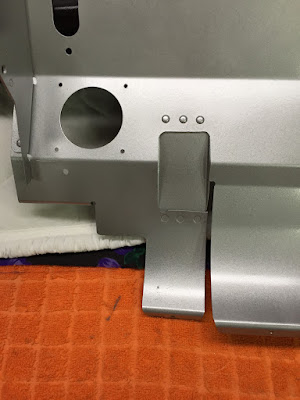
Thanks, Bill.. so far I have cut down the air-dams and added 2 louvers to the bottom of the cowling. Presently even in take-off climb I'm staying below 400F probably not bad with an OAT of 85f. Next time I pull the top cowl I will look at adding a mod as depicted without pulling the baffle.. Thanks again, Mark C. 119RV
Thanks, Bill.. so far I have cut down the air-dams and added 2 louvers to the bottom of the cowling. Presently even in take-off climb I'm staying below 400F probably not bad with an OAT of 85f. Next time I pull the top cowl I will look at adding a mod as depicted without pulling the baffle.. Thanks again, Mark C. 119RV
I added my channel without pulling the baffle also. It's not as pretty as Bill's but does the trick. Was able to carefully cut out a section with the dremel and fabricated a cover channel that is secured on top with blind rivets and on the bottom and sides with RTV. Has worked fine so far and I can pretty it up next time the baffles are off.
I see you are injected so this won't apply to you, but...
That being said, the more I fly the more I am learning that the throttle setting has the most effect on the mixture and thus temperature of the cylinders. At full power the most fuel seems to get to the rear cylinders and they stay cooler. At 75% and 3000' the front cylinders are richer and cooler. This is verified when leaning by EGTs. I am going to work on finding which position of the throttle leads to the best mixture distribution; I have a feeling it is around 85-90% open, so I will need to be pretty high to make that a reasonable cruise power.
Chris
Last edited:
Marc Bourget
Well Known Member
Looking at the image, am I correct in assuming the airflow around the cylinder is "witnessed" by the light blue lines? If so, it appears by the bypass that the baffles never come in contact with the fins? Does this hold true for the heads, as well, in the typical RV installation?
Pls help me get up to speed on this point!
Thanks,
mjb
Pls help me get up to speed on this point!
Thanks,
mjb
Mike S
Senior Curmudgeon
it appears by the bypass that the baffles never come in contact with the fins?
There are virtually no fins in the area where the bypass duct goes. This is the entire problem, and why the duct is needed.
If there were adequate fins, then the fins/baffling would create the passage that the duct does. As things are, the baffling hits a fin less area of the head, and stops the airflow.
See this post from a prior thread. http://www.vansairforce.com/community/showpost.php?p=883897&postcount=23
Last edited:
Marc Bourget
Well Known Member
I had to address this (no fins there) issue with another engine.
It's important to overall cooling performance that the cross-sectional area of the cooling passage above the no-fin area remains limited, close if not equal to the space between the fins.
I ended up making a punch and die and formed them on my press brake.
FWIW
mjb
It's important to overall cooling performance that the cross-sectional area of the cooling passage above the no-fin area remains limited, close if not equal to the space between the fins.
I ended up making a punch and die and formed them on my press brake.
FWIW
mjb
Last edited:
It's important to overall cooling performance that the cross-sectional area of the cooling passage above the no-fin area remains limited, close if not equal to the space between the fins.
Care to expand on that statement ?
Marc Bourget
Well Known Member
DanH asked: "Care to expand on that statement ?"
Sure,
1st, you want to ensure that adequate air mass (# of molecules) flows THROUGH the fins, as that's the only thing that carries heat away.
2nd, you want turbulent air in between the fins to provide more molecule-to-fin contact. No or not much heat transfer occurs via radiation.
3rd, Hopefully, engine designers were aware of Reynolds effect and spaced the fins consistent with the amount of mass necessary to cool the engine and sufficient to insure turbulence in the "hydraulic cylinder" or "cooling tube" (terms used in evaluating fin spacing).
4th, if you have a section that's oversized, more air than necessary flows through, and probably slower, to the point that maybe no turbulence generated, AND, it drops the pressure differential (to some degree, hopefully not too much) for the rest of the engine, reducing the mass that flows through the rest of the "system".
Less mass, less cooling. Significantly less mass can lead to much more loss of cooling than simple drop in mass (consistent with loss of turbulence in the "cooling tube")
Hope the above was clear and responded to your question.
FWIW
mjb
Sure,
1st, you want to ensure that adequate air mass (# of molecules) flows THROUGH the fins, as that's the only thing that carries heat away.
2nd, you want turbulent air in between the fins to provide more molecule-to-fin contact. No or not much heat transfer occurs via radiation.
3rd, Hopefully, engine designers were aware of Reynolds effect and spaced the fins consistent with the amount of mass necessary to cool the engine and sufficient to insure turbulence in the "hydraulic cylinder" or "cooling tube" (terms used in evaluating fin spacing).
4th, if you have a section that's oversized, more air than necessary flows through, and probably slower, to the point that maybe no turbulence generated, AND, it drops the pressure differential (to some degree, hopefully not too much) for the rest of the engine, reducing the mass that flows through the rest of the "system".
Less mass, less cooling. Significantly less mass can lead to much more loss of cooling than simple drop in mass (consistent with loss of turbulence in the "cooling tube")
Hope the above was clear and responded to your question.
FWIW
mjb
Not allowing air to bypass the fins is obvious enough.
Reynolds number is a bit more subtle...
http://www.vansairforce.com/community/showpost.php?p=879210&postcount=53
However, the question here revolves around sizing of an inlet upstream of an orifice. I'll state that it is not possible to "oversize" the section prior to the system orifice. For the most part, flow is controlled by the system orifice, not the approach to the orifice.
Reynolds number is a bit more subtle...
http://www.vansairforce.com/community/showpost.php?p=879210&postcount=53
However, the question here revolves around sizing of an inlet upstream of an orifice. I'll state that it is not possible to "oversize" the section prior to the system orifice. For the most part, flow is controlled by the system orifice, not the approach to the orifice.
Marc Bourget
Well Known Member
Dan, Thanks for the link to the other post. I copied it for my compendium.
You said: "I'll state that it is not possible to "oversize" the section prior to the system orifice. For the most part, flow is controlled by the system orifice, not the approach to the orifice."
I'm in agreement with the first point, but I'm not "grokking" your reference to the "system orifice" as I interpret it as a counter point and my intent was to speak only about the orifice.
What am I missing?
mjb
You said: "I'll state that it is not possible to "oversize" the section prior to the system orifice. For the most part, flow is controlled by the system orifice, not the approach to the orifice."
I'm in agreement with the first point, but I'm not "grokking" your reference to the "system orifice" as I interpret it as a counter point and my intent was to speak only about the orifice.
What am I missing?
mjb
Good discussion Marc. It triggers thinking.
As a practical matter, I don't a believe a TLAR approach will result in an entry ("D" below) that is too large, at least until it gets so large that airflow simply bypasses significant fin area. Although that would reduce heat transfer, actual flow would still be controlled by the orifice...the smallest area in the flow path. With a very large entry, the smallest area in the flow would be "E".
Set that point aside. A bit of thought says your original statement is valid, in so far that we should try to define some considered approach to sizing the bypass.
Below is a view looking in from the the starboard side. Cylinders #1 and #3 share flow area at C, after which that flow splits into areas A and B. Note that C is largely the depth of the fins on the exhaust side of Cyl #3. The classic problem on the intake (rear) side of #3 is that we have no adjacent cylinder to provide flow area.
So, we wish to find a dimension for D. A simple approach might be to approximate the percentage of C which is flow through B:
C(B/A)=D
The resulting dimension D would be a little larger than necessary, as the simple equation does not account for the cross section area of the fins in C. However, it might be a reasonable place to start.
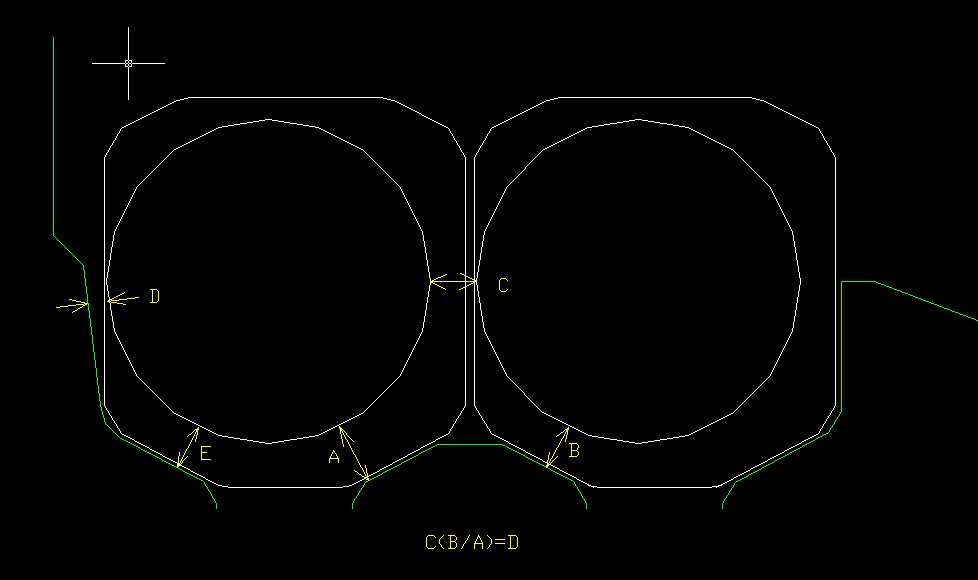
As a practical matter, I don't a believe a TLAR approach will result in an entry ("D" below) that is too large, at least until it gets so large that airflow simply bypasses significant fin area. Although that would reduce heat transfer, actual flow would still be controlled by the orifice...the smallest area in the flow path. With a very large entry, the smallest area in the flow would be "E".
Set that point aside. A bit of thought says your original statement is valid, in so far that we should try to define some considered approach to sizing the bypass.
Below is a view looking in from the the starboard side. Cylinders #1 and #3 share flow area at C, after which that flow splits into areas A and B. Note that C is largely the depth of the fins on the exhaust side of Cyl #3. The classic problem on the intake (rear) side of #3 is that we have no adjacent cylinder to provide flow area.
So, we wish to find a dimension for D. A simple approach might be to approximate the percentage of C which is flow through B:
C(B/A)=D
The resulting dimension D would be a little larger than necessary, as the simple equation does not account for the cross section area of the fins in C. However, it might be a reasonable place to start.

Last edited:
Marc Bourget
Well Known Member
Will a D constructed to large lose turbulence?
My thought is, if the D dimension is about equal to fin spacing, it would work towards preserving turbulence and assist in maintaining pressure differential, overall.
On a different consideration, all else being approximately equal, will a 5.5" H2O Delta P preserve intra-cylinder velocity, irrespective of top vs. bottom absolute pressure readings?
Regards,
Marc
My thought is, if the D dimension is about equal to fin spacing, it would work towards preserving turbulence and assist in maintaining pressure differential, overall.
On a different consideration, all else being approximately equal, will a 5.5" H2O Delta P preserve intra-cylinder velocity, irrespective of top vs. bottom absolute pressure readings?
Regards,
Marc
Will a D constructed to large lose turbulence?
Don't care....no fins there.
My thought is, if the D dimension is about equal to fin spacing, it would work towards preserving turbulence and assist in maintaining pressure differential, overall.
Empirical evidence says no. I started with a very small slot and later went larger, which lowered cylinder temperature. Other reports mirror the trend. That suggests increased mass flow trumps velocity increase in the pinch area.
On a different consideration, all else being approximately equal, will a 5.5" H2O Delta P preserve intra-cylinder velocity, irrespective of top vs. bottom absolute pressure readings?
DeltaP is the difference between top and bottom absolute pressures. And there's no magic in 5.5". The required deltaP (i.e. mass flow in lbs/sec) varies with density (i.e. altitude) and power setting.
BillL
Well Known Member
Will a D constructed to large lose turbulence?
My thought is, if the D dimension is about equal to fin spacing, it would work towards preserving turbulence and assist in maintaining pressure differential, overall.
On a different consideration, all else being approximately equal, will a 5.5" H2O Delta P preserve intra-cylinder velocity, irrespective of top vs. bottom absolute pressure readings?
Regards,
Marc
1. It does not matter the initial flow is not turbulent as it will be 5 fin spacings into the channel.
2. Reynolds numbers show that the flow in the fins is well into turbulent flow even with low speed climbs (5.5" pressure drop). So, heat transfer coefficient is still very good. Cylinder and head fins.
My opening area at the pinch point (centerline of the head) is about 80% of the fin area down at E. Without the fin thickness it is not much, like 0.2". Being concern about how much flow there was, I made a nozzle with those dimensions and put it on the end of a vacuum on blow. At 10" h20 pressure it is amazing how much flow there is in that slot. I now use that as a vacuum nozzle in the shop.
I was concerned about this when making mods to my engine and did the calculations for parallel plates for the fins and a rectangular channel for the cylinders with a cylinder wrap. No problem what-so-ever. Apparently, the designers were aware.
Good discussion on this, understanding the relative effects of these things is important.
PS - all dimensions off a M1B parallel valve engine.
rzbill
Well Known Member
This discussion of fins reminds me of a point that was introduced in my Heat Transfer class. Just a point of idle interest...
We know pretty much all cooling fins are made straight and parallel.
The first pass with the thermodynamics math says they should be parabolic. Wide at the root and skinny at the top.
Yea, so...we were yawning.. (we studied all night y'know
(we studied all night y'know  )
)
BUT, on deeper analysis, the graph plots had points that did not lie on the basic parabolic curve. By looking closer, it turns out that the parabolic curve was the centerline of what looked like a sine type wave. So.. the fin cross section really looked a lot like a Christmas tree
We were talking about this in 1980 about the time that Mandelbrot was doing his thing but it was not well known yet. Now I seriously wonder if the most efficient fin is really a fractal and we did not know it.
Of course it would be very difficult or impractical to manufacture.
We know pretty much all cooling fins are made straight and parallel.
The first pass with the thermodynamics math says they should be parabolic. Wide at the root and skinny at the top.
Yea, so...we were yawning..
BUT, on deeper analysis, the graph plots had points that did not lie on the basic parabolic curve. By looking closer, it turns out that the parabolic curve was the centerline of what looked like a sine type wave. So.. the fin cross section really looked a lot like a Christmas tree
We were talking about this in 1980 about the time that Mandelbrot was doing his thing but it was not well known yet. Now I seriously wonder if the most efficient fin is really a fractal and we did not know it.
Of course it would be very difficult or impractical to manufacture.
Marc Bourget
Well Known Member
Bill L said: " Reynolds numbers show that the flow in the fins is well into turbulent flow even with low speed climbs (5.5" pressure drop)."
What will Reynolds calcs show us as to how low of a pressure drop will still produce turbulence?
If pressure recovery ranges between .6 and .85 and 100 mph gives us 4.94" H2O, we're down to 3" with a poor cowl installation.
So, what can we count on ??
thanks, btw.
What will Reynolds calcs show us as to how low of a pressure drop will still produce turbulence?
If pressure recovery ranges between .6 and .85 and 100 mph gives us 4.94" H2O, we're down to 3" with a poor cowl installation.
So, what can we count on ??
thanks, btw.
If pressure recovery ranges between .6 and .85 and 100 mph gives us 4.94" H2O, we're down to 3" with a poor cowl installation. So, what can we count on ??
Let's polish a few points.
4.94" available Q would be at sea level, so at any realistic altitude (or high density altitude), theory says we don't even have that much.
The stated velocity of 100 MPH (87 knots) is somewhat slower than normal RV climb speed. It does illustrate how difficult the cooling issue can become with STOL aircraft, IF they are expected to maintain high AOA and full power for an extended period. It's not a problem for either if we're just doing a quick climb to clear the trees.
A subtle detail...velocity for Q calculations assumes true airspeed, not indicated airspeed. Readers doing pressure measurements must convert to TAS when calculating available Q, or the pressure recovery ratios will appear better than they really are.
On the positive side, we usually assume steady state level flight when calculated available Q. With an RV, the given 87 KTAS in level flight would be at a very low power setting, thus there would be little velocity in the propeller outflow. A climbing RV with a big motor at 27/2700 and 87 KTAS would have quite a lot of prop outflow. The trick is to harvest that outflow velocity as increased upper plenum pressure. So far, it appears there is a lot of variation in this area. RVs with inboard inlet area (closer to the spinner) and prop blades with inefficient blade root airfoils (like the round roots seen on some composite CS props) are not going to get much increased Q due to prop outflow. Efficient inboard blade sections and good outboard inlets can harvest quite a lot. The 390/Hartzell BA/outboard low ratio inlet combination is picking up about 33% compared to Q due to aircraft velocity alone.
CR3405, prop outflow as a function of blade radius:
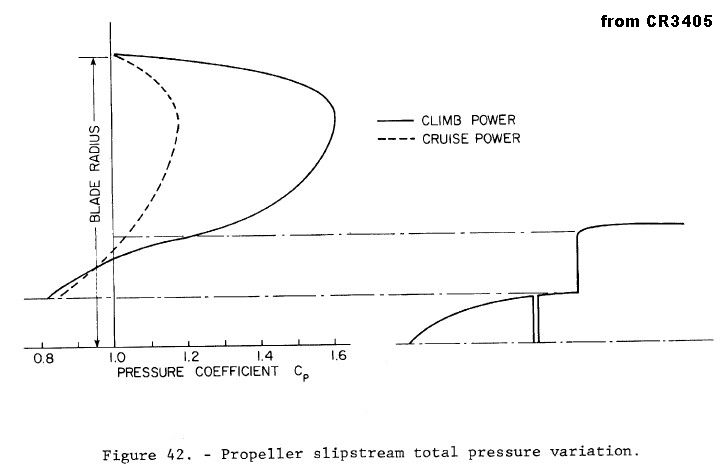
Last edited:



